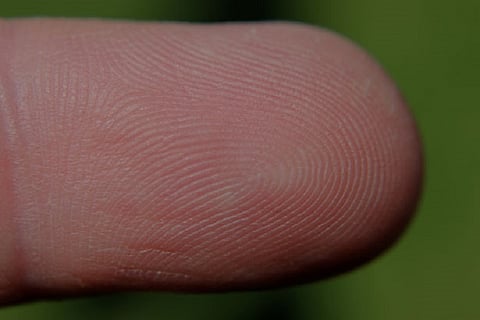

It's been 125 years since Argentinian researcher Juan Vucetich developed a classification system to record the identity of prisoners using their fingerprints, as DW reported. The first murder case was solved using the technique a year later.
Here are some of our favorite crime novels that would have turned out quite a bit differently if it weren't for the invention of fingerprinting.
1. Mark Twain: "Life on the Mississippi" (1883)
The first literary mention of fingerprints is found in Mark Twain's memoir, "Life on the Mississippi." Published in Boston in 1883, the book's narrative looks back at the author's early life working as a steamboat pilot along the Mississippi River before and after the Civil War. In it, he details how a bloodied fingerprint helped solve a murder trial - well before forensic science adopted the technique and made it a commonplace tool in investigations.
2. Arthur Conan Doyle: "The Return of Sherlock Holmes" (1903)
The world's most recognized master detective in fiction, Sherlock Holmes, is renowned for his keen observations as much as he is for his love of breakthrough Victorian technology. Doyle's character keeps inventing new gadgetry to put together the pieces of the crime puzzles he is faced with. Going beyond fingerprints, the tales of Sherlock Holmes also feature cigarette ashes and footprints as evidence. The adventures of the detective have been retold in numerous films over the years, culminating most recently in the British TV series "Sherlock" featuring Benedict Cumberbatch.
3. George Simenon: "A Battle of Nerves" (1930)
This first installment in a series of 19 crime novels featuring the protagonist Jules Maigret takes a close look at fingerprints and footprints as key evidence in the hunt for a murderer. Chief inspector Maigret uses his intuition and experience to catch criminals in Paris - rather than relying solely on evidence. His approach pays off: Despite a number of clues (including fingerprints) that have placed a particular suspect on death row, Maigret finds the real culprit, who, driven by greed, had actually committed the gruesome murder of a diplomat's widow.#b
4. Patricia Wentworth: "The Fingerprint" (1959)
It takes more than just a fingerprint to solve a crime, at least in most cases. Sometimes, the discovery of fingerprints can actually hinder an investigation or produce false suspects. In Patricia Wentworth's 1959 novel, "The Fingerprint," a young woman discovers the lifeless body of her uncle lying next to a gun. Without thinking, she picks up the weapon, unwittingly making herself the prime suspect by leaving her fingerprint on it. That's when Wentworth's popular protagonist Miss Maud Silver steps up to the plate - a retired teacher with a knack for solving crimes.
5. Andre Hunebelle: "Fantomas" (1964)
The fictional character Fantomas exemplifies the weight that fingerprints have come to carry in forensic science. Fantomas manages to continually mislead the police - by hiding behind his rich collection of masks and never leaving any fingerprints at his murder scenes, with gloves fashioned from human skin hiding his grisly crimes. Stories about the criminal mastermind have kept French audiences entertained for more than century. Though always a villain, the story of Fantomas speaks to the strange relationship between the French and their authorities - so much so that in the 1960s the serial killer's ability to outwit the police was turned into a celebrated comedy film featuring Louis de Funes.
6. Bruce A. Evans: "The Talented Mr. Ripley" (1999)
American author Patricia Highsmith highlighted the adventures of her protagonist Tom Ripley throughout a series of her crime novels starting in 1955, which were later picked up by French director Rene Clement in 1960. His adaptation "Plein Soleil" featuring Alain Delon introduced the story of the unscrupulous murderer to a broader audience. But it wasn't until 1999 that the narrative of Mr. Ripley gained worldwide acclaim, with Hollywood actor Matt Damon delivering a stunning performance in the role. The story centers on the murder of Dickie Greenleaf, the wayward son of a rich New York industrialist. Tom Ripley assumes Greenleaf's identity in a bid to qualify for his inheritance. However, his fingerprints almost betray him in due course.
7. Stieg Larsson: "The Girl Who Played with Fire" (2006)
Stieg Larsson is celebrated as one of the bestselling authors of our time, but tragically never got to witness his stellar success for himself, having died just two years before "The Girl Who Played with Fire" became an international bestseller. It was later adapted as a successful movie franchise as well, featuring Daniel Craig as protagonist Mikael Blomkwist, whose millionaire girlfriend is suspected of murder, with her fingerprints found on the weapon.
To make matters worse, IT expert Lisbeth Salander also suffers under a severe personality disorder, raising further suspicions and putting the odds against her. But magazine editor Blomkwist continues to believe in her innocence and starts his own investigation.
(The article was first published on DW. You can read the original article here.)